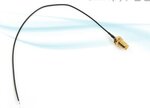Tyler Grey
Junior Member level 1
i'm trying to make the signal of my WIFI router go directional by using directional patch antennas.
But since my WIFI router does not have detachable antennas, I'm thinking of soldering SMA connectors to the board which look like the picture below.
So I'm planning to solder connectors which will go to the antennas like the picture below, but found out somebody saying that soldering might degrade the signal making them unreliable.
Q1. Would soldering antenna wires actually degrade WIFI signals?
Q2. If I don't stick with soldering, would putting two contact points together work?
Like just putting them together by a tape or hot glue.

Any help would be appreciated
But since my WIFI router does not have detachable antennas, I'm thinking of soldering SMA connectors to the board which look like the picture below.
So I'm planning to solder connectors which will go to the antennas like the picture below, but found out somebody saying that soldering might degrade the signal making them unreliable.
Q1. Would soldering antenna wires actually degrade WIFI signals?
Q2. If I don't stick with soldering, would putting two contact points together work?
Like just putting them together by a tape or hot glue.

Any help would be appreciated